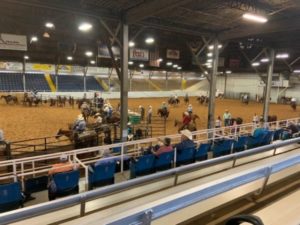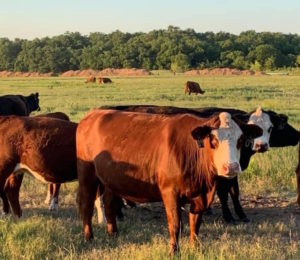
A WCHA show at Ardmore, OK.
Have you ever wanted to host your own local cutting show? It might not be as daunting as you think. But whether it’s big or small, there are definitely some steps you need to take to make a show happen.
“It’s a simultaneous combustion that happens that lets you have a show,” said experienced show producer Dee McLauchlin. McLauchlin is a show secretary for multiple shows in Texas and Oklahoma.
“I have the world’s best sandbox and everybody comes and plays in it,” McLaughlin said laughing.
Gwen Coie is the Secretary for the Southern Futurity and the Cotton Stakes and helps out the NCHA with the Eastern Nationals when needed. She is also in the River City Cutting Horse Association that hosts four two-day shows a year.
Coie describes the role of secretary as being like a command center.
When putting on a show it’s important to realize that it takes time to plan, especially for the very first one. Coie said for the major limited aged events she gives the NCHA a three to five year projection of show dates. For the Cotton Stakes in September, she finalized plans for the show in May, six months in advance.
Cutting shows do not have to be affiliated with the NCHA. It all depends on what best serves your cutting community. Some local NCHA associations also host shows that are not NCHA-approved. Each option has its pros and cons. By not being an NCHA affiliate or not having the show NCHA approved, you can run the show however you want and host the classes in the order of your choosing. You can also create your own classes and other rules. It does cut costs because you don’t have to have a videographer, or pay the NCHA fees (the NCHA gets a percentage of the entry fees).
Clements Cutting Club is an example of an NCHA affiliate that also hosts shows that are not NCHA approved shows. Trainer and President of Clements Cutting Club, Dylan Meyer said,“It’s been a stepping stone for a lot of cutters in California. It’s bridged the gap between people being introduced to cutting and really becoming highly competitive…It’s been a tremendous stepping stone for the careers of young trainers in this area…so when they do step up they are ready.”
“We try to keep the club cuttings as affordable as possible. We also like to have as much flexibility as possible for our trainers so our trainers have the opportunity to work or school as many horses as they need to. And there’s no extra fees,” Meyer said of hosting non-NCHA approved shows.
However, the upside of being an NCHA affiliate is having its support. Most show producers are NCHA affiliated and run NCHA approved shows where all earnings and points are counted. The NCHA has spent years refining its rule book and has tried and true systems for hosting successful shows. And importantly, affiliates get insurance coverage through the NCHA.
Step 1: Decide what type of show you want to have.
Think of your local cutters and what would best suit them, weekend cutters or Limited Aged Event competitors or both? You need to be able and willing to do things by the NCHA guidelines if you are an affiliate. There are many specific rules and regulations in the NCHA manual listed that need to be thoroughly understood. Read the Cutting Horse Chatter and stay up to date with the haulers. Stay informed on what other associations or clubs are doing to tailor shows to the people in their area, McLauchlin advised.
Step 2: Look at your finances.
The biggest challenge is the expense of putting on a show. Create a budget that includes the facility rental, the cattle costs, and the personnel that need to be compensated. Coie said it can be hard to make the show break even without passing too much of the extra expense onto the cutters.
Step 3: Decide the date.
Get approval well in advance if it’s an NCHA show. Go through every resource on the internet to avoid conflicting with other shows.
Step 4: Secure a facility.
Make sure it has good ground. No one wants to show their horse if it means risking injury because the ground is bad or ill-prepared. “They have to be able to get to your facility and want to come to your facility,” said McLauchlin.
The venue needs to have some basic amenities. Not everyone wants to use a port-a-potty or drive down a pothole-filled road to get to the show.
Jake Meeks, President of the Kentucky Cutting Horse Association said, “Stay in tune to what [cutters] appreciate.” Meeks said you don’t have control over everything but make sure you offer great service where you can, such as preparing the ground, cattle handling and creating a friendly environment.
“The hospitality of your guests [is something you can control]. Make sure that if [something] is brought to your attention [you] do the best you can to fix it. There are so many factors in cutting that you have no control over. If you try to manage those things you’ll drive yourself crazy. Fix what you can fix and help who you can help,” Meeks added.
Step 5: Decide on added money and find local sponsors.

Find a good cattle
supplier.
Step 6: Start marketing your show if you haven’t already done so via social media, emails, mail-outs, announcements at other shows, word of mouth, local venues etc.
Step 7: Find a cattle supplier. Get a cow handler lined up. McLauchlin said don’t be the secretary that is also managing the cows. Get a designated cow person that knows how to feed and water cattle and keep an eye out for sick cows.
Step 8: Hire a judge. The caliber judge needed depends on the added money.
Step 9: Hire announcer and videographer. When putting on a show, be sure that all of the people working, helping and running the show know their jobs and can do their jobs very well. It helps the show run smoothly.
Someone needs to water, drag and prep the arena, and add more sand if needed. Decide who is bringing the cows in and out of the arena. If it is a multi-day show, hay and shavings should be available to purchase and someone needs to be in charge of organizing stalls.
Any NCHA show is required to have at least one videographer so the judge can go back and watch a run. Most shows have a photographer as well.
McLauchlin said, “You have to be able to work with your cutters if you want them to come back. We, as secretaries, are supposed to be in the service business. I am here to serve you. I am here to make sure you have the best experience and want to come back to our show.”
Step 10: A good show needs a positive atmosphere, and a good payout. For local shows, it’s good to have a dinner where the competitors can get together and socialize. Also it is great to include fun prizes, Coie said.
“Those extra things mean a lot and they go a long way with people,” said Coie.
Step 11: Paperwork needs to be filled out with the NCHA to get the show approved if it’s an NCHA affiliate. If it’s not, then make sure to have liability insurance in place.
Step 12: Last but not least, don’t forget to have a well stocked candy bowl. Sometimes it is the trainer’s and loper’s breakfast, lunch, dinner and midnight snack. Scheduling McLauchlin said the cattle dictate what order the show is run.
“There are certain classes we cannot have added money in, the $35K, $15K Am and $2K Ltd and they are re-run cattle classes.” McLauchlin said if you have six riders in the open, that’s 18 re-run cows, six cows in the non-pro, that’s another 18 (making 36 available cows) and then you get to the $15K Am with 20 horses, where you need 45-50 cows which won’t be available yet.
“You have to adjust that schedule so you have used enough fresh cattle to be able to have re-run cattle classes…You set up the classes based on the people that are coming to your show,” said McLauchlin, who is skilled at hosting efficient shows.
For example, if the show is catering to the weekend haulers, schedule those classes earlier in the day so they can get in and get out.
While many like being able to pre-enter, McLauchlin is not a fan of the pre-draw because things can change. The secretary has to order cows for the show by a certain time the day before. McLauchlin tries to give everyone wiggle room if something goes wrong, be it a blow out, or a sore horse etc. She said she only has to charge for the cows and not all of the other fees. Sometimes she can sell unused cows to a cutter that entered late, saving the person that scratched from paying anything.
“I’m never going to tell somebody they can’t come to the show. I cannot let you be in a position that would take someone’s cows so you would have to go last in the class.”
Make sure to have a backup plan when things go wrong like a sick judge, cattle getting loose or a printer breaking. Talk to cutters and get their input. McLauchlin said most of the time the cutters will come up with a solution that has the best outcome for everyone.
Time management
“You can never be in control of a cow and you can never be totally in control of your judge. You can be in control of the ground, weather permitting, and you can be in control of your promptness and your ability to get your show up and running at the proper time. Don’t drag your feet in between classes, don’t be making people wait on you to draw a class. Don’t give them an excuse to say, ‘we had to sit around forever.’ Make sure you’re reducing their wait time as much as possible,” said McLauchlin.
McLauchlin suggested keeping everyone up-to-date with what class the show is on via Facebook.
Meeks said handling the growth is a constant challenge. The question is how to allow for more competitors without making the days longer? “The answer [for us] would be [to add] days to steadily even it out,” said Meeks.
Ashley Hallinan has been a secretary for over 10 years helping different cutting groups on the west coast, such as Outback Cuttings, Clements Cutting Club, Redwood Empire Cutting Horse Association, as well as the PCCHA. She said the Clements Cutting Club show has a pen rotation schedule. They have two pens they rotate through, where they show in one pen while dragging and settling cows in the other. That way they get through 150-180 works and everyone gets home at a reasonable hour.
For a complete overview of all of the rules and regulations, see the NCHA Manual.
